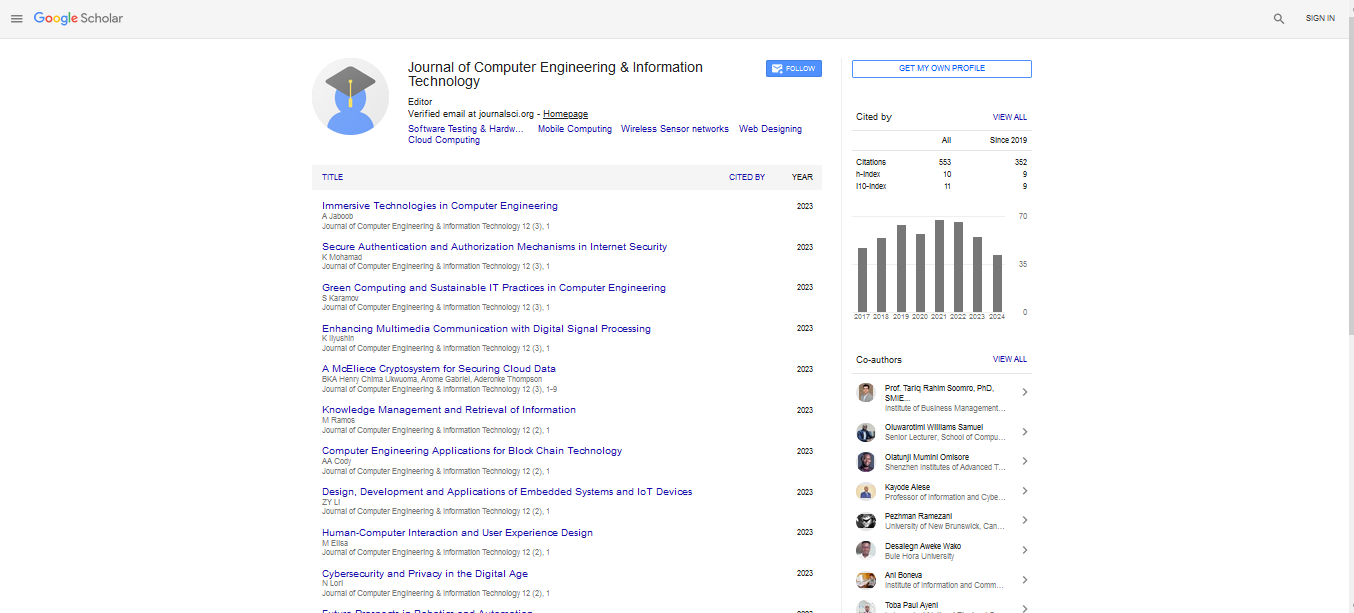Opinion Article, J Comput Eng Inf Technol Vol: 13 Issue: 6
Quantum Computing: Implications for Modern Cryptography and Data Encryption
Marcos Popoola*
1Department of Computing, Sheffield Hallam University, Sheffield, UK
*Corresponding Author: Marcos Popoola,
Department of Computing, Sheffield
Hallam University, Sheffield, UK
E-mail: marcos.popoola@shu.ac.uk
Received date: 27 October, 2024, Manuscript No. JCEIT-24-151670;
Editor assigned date: 29 October, 2024, PreQC No. JCEIT-24-151670 (PQ);
Reviewed date: 13 November, 2024, QC No. JCEIT-24-151670;
Revised date: 21 November, 2024, Manuscript No. JCEIT-24-151670 (R);
Published date: 29 November, 2024, DOI: 10.4172/2324-9307.1000317
Citation: Popoola M (2024) Quantum Computing: Implications for Modern Cryptography and Data Encryption. J Comput Eng Inf Technol 13:6.
Description
Quantum computing, a field that marries principles of quantum mechanics with computational science, is poised to revolutionize the digital landscape. By holding quantum superposition and entanglement, quantum computers are expected to solve complex problems that are beyond the reach of classical computers. One of the most prominent areas that quantum computing will impact is cryptography and data encryption. Modern encryption algorithms, which form the backbone of secure communication, might become vulnerable in the era of quantum computing. This paper discuss the foundations of quantum computing, its principles and its implications for modern cryptography and data encryption. Quantum computing represents a paradigm shift in computational power and logic, grounded in the properties of quantum mechanics. Unlike classical bits, which exist in binary states (0 or 1), quantum bits, or qubits, can exist in super positions, meaning they can represent 0 and 1 simultaneously. This characteristic exponentially increases the processing power, enabling quantum computers to perform complex calculations at unprecedented speeds.
This approach relies on error-correcting codes, specifically the difficulty of decoding random linear codes. Code-based cryptography has been studied for decades and is considered a viable option for public key encryption and digital signatures. This method is based on the difficulty of solving systems of multivariate polynomial equations over finite fields. While bonding, multivariate polynomial cryptography requires further research to ensure practicality and efficiency. Developing and implementing standardized quantum-resistant algorithms is a priority. Organizations like National Institute of Standards and Technology (NIST) are working to establish protocols for quantum-safe cryptography. Replacing established cryptographic systems with quantum-resistant alternatives is challenging. Backward compatibility, hardware support and integration with existing systems require careful planning. Educating organizations and individuals about the potential risks of quantum computing to cryptography is essential. The shift to quantum-resistant algorithms will require widespread adoption across industries. In the transition phase, hybrid encryption techniques that combine classical and quantum-resistant algorithms can provide additional security.
These methods involve using classical encryption with quantumresistant layers for enhanced protection. While quantum computing poses risks to traditional cryptography, it also offers opportunities for developing quantum-based security solutions, such as Quantum Key Distribution (QKD). QKD uses the principles of quantum mechanics to distribute encryption keys securely. If an eavesdropper attempts to intercept the key, the quantum states will collapse, alerting the parties to the intrusion. QKD is currently a resource-intensive technology, but it potentials to deliver unbreakable security in future communications. Quantum computing is set to disrupt the field of cryptography and data encryption fundamentally. As quantum computers become more advanced, traditional encryption algorithms will no longer provide sufficient security, especially those that rely on mathematical problems susceptible to quantum algorithms.
This transformation necessitates the development and adoption of quantum-resistant cryptographic techniques to secure digital communications. The transition to quantum-safe systems will require coordinated efforts from governments, organizations and researchers. Standards bodies like NIST are leading the way in establishing postquantum cryptographic standards, but the path forward remains challenging. In addition to securing classical cryptography against quantum threats, emerging technologies like Quantum Key Distribution offer new possibilities for secure communication. Embracing these changes will be essential to safeguard digital systems in the quantum era, ensuring that encryption remains robust against even the most advanced computational threats.
 Spanish
Spanish  Chinese
Chinese  Russian
Russian  German
German  French
French  Japanese
Japanese  Portuguese
Portuguese  Hindi
Hindi 